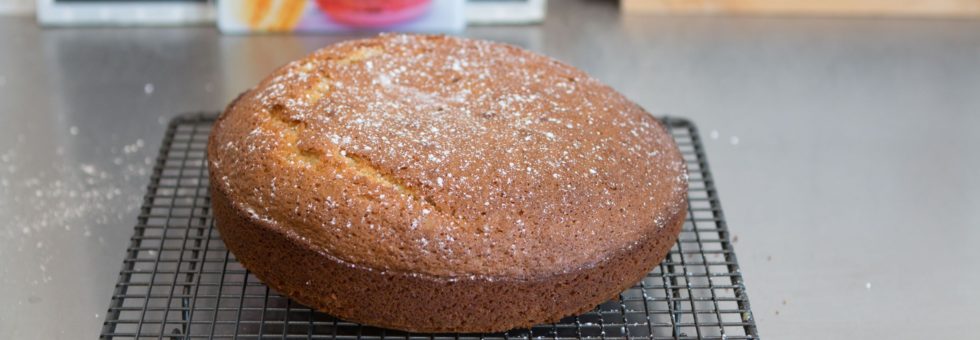This week I chose a Spanish “bizcocho de yogur”, a traditional yoghurt sponge cake. This one contains both lemon zest and lemon yoghurt, for an extra tangy boost. Its unassuming aesthetics hide a cake bursting with flavour. The recipe says it is ideal for breakfast or a snack. Cake for breakfast is never a bad idea.
Baking
The actual baking was straight forward and the source website helpfully contains a video so you can get an idea of the process. In contrast to my usual English recipes, this ones aptly uses olive oil for the fat, instead of butter. It is made by combining lightly whisked eggs with sugar, and adding the yoghurt and oil. The lemon zest is then incorporated and the flour and baking powder sieved in. Since the recipe doesn’t say what size tin to bake it in, it’s useful to see what the chef used (a Pyrex dish). I opted for the usual round 20cm cake tin as it’s what I’m used to. A few handy tips are given at the end of the recipe, including to make sure you only grate the rind of the lemon and not the pith, as it will add a bitter flavour.
Lemon yoghurt
The recipe uses lemon yoghurt, which is actually not as easy to come by in the UK as it is in Spain. Ideally you would use a small yoghurt pot, as this would later be used to measure out the flour and sugar. However, I could only find one brand of lemon yoghurt in a large pot. Lemons are an inherent part of Spanish culture, readily available and grown in substantial quantities. It is unsurprising that they feature in many food products, including yoghurts. However, in the UK we seem to have a preference for berry, tropical and stone fruit flavours in yoghurts. Having now tried it, I would highly recommend it and don’t know why we don’t embrace lemon yoghurt more.
Beat, whisk or fold?
It seems that in French and Spanish vocabulary it is not always obvious whether a mixture needs beating, whisking folding or simply mixing, but the difference is important to making the recipe a success.
I had an interesting insight into the vocabulary used in these different contexts. In Spanish, the verb “batir” can mean beat, whisk or blend, which are very different actions with very different purposes. The recipe attempts to clarify the difference, e.g. by saying “batir con una varilla”, meaning to beat using a [literally] rod/stick/wand, i.e. to whisk. The author states this is key to achieving a fluffy cake, and discourages the use of a “batidora de hélice”, literally a beater with a propeller, i.e. a blender/food processor.
The recipe asks you to sieve the baking powder and flour into the wet ingredients and “mezclar bien”, literal translation: mix well. However, having just sieved the dry ingredients to allow air into the mixture, you don’t want to knock it all out again by simply mixing or beating the ingredients. The dry ingredients need to be folded in, a term which seems to be lacking in many of the Spanish recipes I have seen. Maybe it wouldn’t make much difference in this case. After all the recipe does use a whopping 16g baking powder! It would take a special kind of skill to not make the cake rise!
Chronology
When the mixture is ready, the recipe tells you to put it into the preheated oven. This instruction comes a little too late, as cake mixture should not be sat around for long before baking, and it also needs to go in at the appropriate temperature. The baker would probably skip ahead and find the oven temperature in preparation, however it’s always useful for this information to be presented at the beginning of the instructions, as in a normal English recipe.
Beyond measure
As I alluded to earlier, unusually, the recipe lists the quantity of flour and sugar not in grams, not in cups, but in “medidas de yogur”, i.e. yoghurt pots. I had never come across this before. Since I couldn’t find a small lemon yoghurt to measure I needed to do some research to find the exact measurements required. Many small yoghurt pots in my local supermarket hold 120g yoghurt, so this was a good starting point. I then found this website which gives the following equivalent measurements in grams for flour and sugar, and ml for liquids:
VASOS DE YOGURT
1 vaso de yogurt de harina: 90 gramos
1 vaso de yogurt de azúcar blanco: 130 gramos
1 vaso de yogurt de liquido: 125 ml
120g wasn’t far off the required 130g. I’m curious as to how engrained in Spanish culture a “medida de yogur” is and whether it is as mainstream as US cups.
Overall
The cake turned out well-risen and packed with zesty flavour. However, the 16g baking powder was certainly noticeable in the taste and seemed to be a high ratio to use. Lemon yoghurt was a big takeaway from the recipe. The finish is quite plain and I would usually add more decoration than icing sugar to a cake, or at least a filling. However, it makes for a pleasant snack (or breakfast…).
Next week I’ll be cooking up something French and fruity…



